PARALLEL AND PERPENDICULAR POSTULATES
Subscribe to our ▶️ YouTube channel 🔴 for the latest videos, updates, and tips.
Relationship between Lines
Two lines are parallel lines, if they are coplanar and do not intersect. Lines that do not intersect and are not coplanar are called skew lines. Similarly, two planes that do not intersect are called parallel planes.
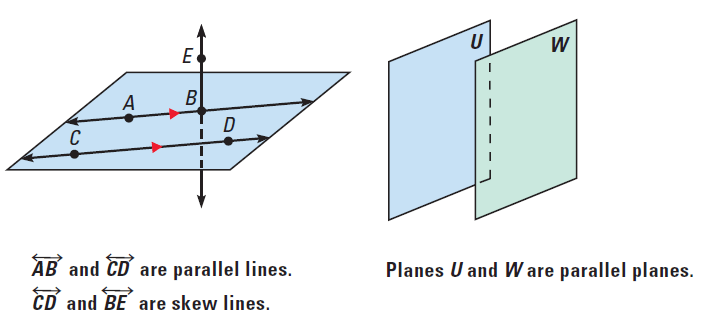
When two lines AB and CD are parallel, we can write it as AB||CD. Triangles like those AB and CD are used on diagrams to indicate that lines are parallel. Segments and rays are parallel if they lie on parallel lines.
For example, AB||CD.
Parallel Postulate
If there is a line and a point not on the line, then there is exactly one line through the point parallel to the given line.
The diagram given below illustrates this.
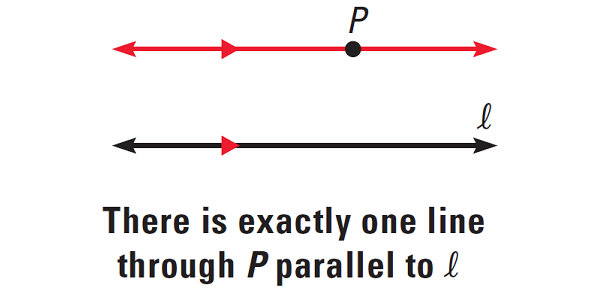
The fifth postulate of Euclidean Geometry states that through any given point not on a line there passes exactly one line parallel to that line in the same plane. This is called Parallel Postulate.
Perpendicular Postulate
If there is a line and a point not on the line, then there is exactly one line through the point perpendicular to the given line.
The diagram shown below below illustrates this.
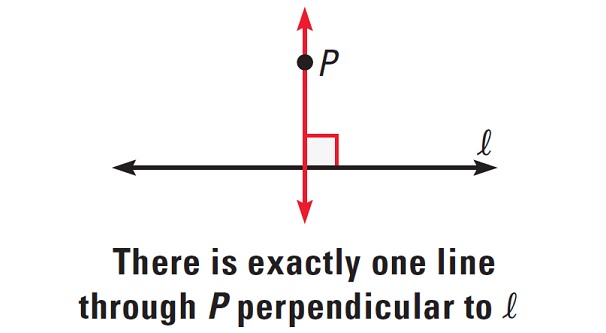
Problem 1 :
Think of each segment in the diagram as part of a line. All the angles are right angles. Which line(s) or plane(s) contain point B and appear to fit the description?
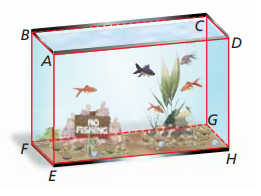
a) line(s) parallel to CD
b) line(s) perpendicular to CD
c) line(s) skew to CD
d) plane(s) parallel to plane CDH
Solution :
a) For line CD, the parallel lines are GH, FE and BA.
b) DH, AE, BF and CG are the perpendicular to CD.
c) The lines which donot intersect and they are not parallel is called skew lines. For the line CD, we have the following relationships.
|
1) AB - Parallel 2) BC - intersecting 3) CD - 4) AD - intersecting 5) BF - skew 6) AE - skew |
7) FH - skew 8) EG - skew 9) DG - intersecting 10) CH - perpendicular 11) GH - parallel 12) FE - parallel |
So, the skew lines are BF, AE, FH and EG.
Problem 2 :
The given line markings show how the roads in a town are related to one another.
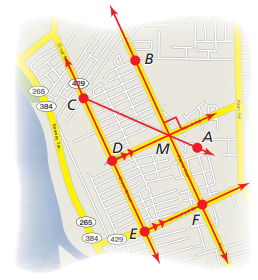
a. Name a pair of parallel lines.
b. Name a pair of perpendicular lines.
c. Is FE || AC ? Explain.
Solution :
a)
- MD and FE are parallel lines.
b)
- For DM, BF is perpendicular.
c) FE is not parallel to AC, because MD is parallel to FE , and by the Parallel Postulate, there is exactly one line parallel to FE through M.
Problem 3 :
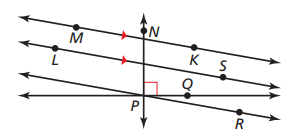
i) Name a pair of parallel lines.
ii) Name a pair of perpendicular lines.
Solution :
i) MS and LS are parallel lines.
ii) NP and PQ are perpendicular lines.
Problem 4 :
Think of each segment in the fi gure as part of a line. Which line(s) or plane(s) appear to fi t the description?
a. line(s) parallel to CD and containing point A
b. line(s) skew to CD and containing point A
c. line(s) perpendicular to CD and containing point A
d. plane(s) parallel to plane EFG and containing point A
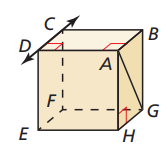
Solution :
a. AB, HG, and EF all appear parallel to CD, but only AB contains point A.
b. Both AG and AH appear skew to CD and contain point A.
c. BC, AD, DE, and FC all appear perpendicular to CD, but only AD contains point A.
d. Plane ABC appears parallel to plane EFG and contains point A.
Problem 5 :
Think of each segment in the diagram as part of a line. Fill in the blank with parallel, skew or perpendicular,
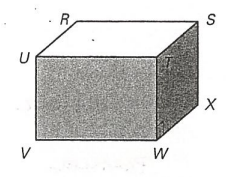
1) UT and WT are ____
2) RS and VW are ____
3) TU and WX are ____
4) Plane YWT and plane RSX are _______
5) TW and WX are ______
Solution :
1) UT and WT are perpendicular.
2) RS and VW are parallel.
3) TU and WX are skew.
4) Plane YWT and plane RSX are parallel.
5) TW and WX are perpendicular.
Problem 6 :
All of the figures below illustrate parallel lines except
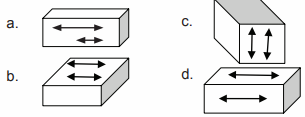
Solution :
Option d consists of two lines in the different planes, so they may not be parallel.
Problem 7 :
Use the photo to decide whether the statement is true or false. Explain your reasoning
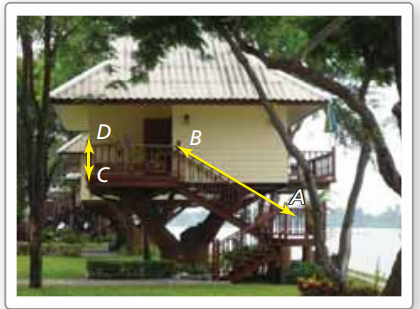
a. The plane containing the floor of the tree house is parallel to the ground.
b. The lines containing the railings of the staircase, such as AB, are skew to all lines in the plane containing the ground.
c. All the lines containing the balusters, such as CD, are perpendicular to the plane containing the floor of the tree house
Solution :
a. The plane containing the floor of the tree house and the ground are parallel. It is true.
b. Skew lines will not be parallel or intersecting, considering the line AB and a line from the ground, they may meet. So, the lines are not skew line. Then it is false.
c. The line CD and the lines from the ground are perpendicular. So, it is true.
Problem 7 :
Which of the following statements is always true?
a. Lines that do not intersect are parallel lines.
b. Two coplanar lines that do not intersect are parallel lines.
c. Lines that form a right angle are parallel lines.
d. Skew lines are parallel lines
Solution :
Two coplanar lines they donot intersect are parallel lines. Option b is correct.
Subscribe to our ▶️ YouTube channel 🔴 for the latest videos, updates, and tips.
Kindly mail your feedback to v4formath@gmail.com
We always appreciate your feedback.
About Us | Contact Us | Privacy Policy
©All rights reserved. onlinemath4all.com

Recent Articles
-
90 Degree Clockwise Rotation
Jan 01, 26 06:58 AM
90 Degree Clockwise Rotation - Rule - Examples with step by step explanation -
US Common Core K-12 Curriculum Algebra Solving Systems of Equations
Jan 01, 26 04:51 AM
US Common Core K-12 Curriculum - Algebra : Solving Systems of Linear Equations -
Solving the HARDEST SAT Math Questions ONLY using Desmos
Dec 31, 25 05:53 AM
Solving the HARDEST SAT Math Questions ONLY using Desmos
